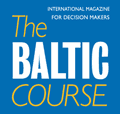
All rights reserved.
You may not copy, reproduce, republish, or otherwise use www.baltic-course.com content
in any way except for your own personal, non-commercial use.
Any other use of content requires the hyperlink to www.baltic-course.com.

Printed: 03.05.2024.
 PrintCommission’s vision on the EU’s future by 2025
PrintCommission’s vision on the EU’s future by 2025
 |
|---|
Commission President Juncker, in line with his State of the
Union of 14 September 2016, presented in the start of March a White
Paper on the future of Europe in order to launch the debate ahead of
the Rome Summit. The White Paper will serve to steer the debate among the EU Heads
of State or Government and help both a structure the discussion at the Rome
Summit and reflect on the EU’s future. Thus the White paper will be used as the starting point for a wider public
debate on the European future.
Facing the new EU summit
Present White Paper on
the Future of Europe, involves Commission's contribution to the Rome Summit
of 25 March 2017 celebrating the 60th anniversary of the Treaties of
Rome.
Sixty years ago, inspired by a dream of a peaceful, common
future, the EU's six founding members embarked on an ambitious journey of
European integration, with the signing of the Treaties of Rome. They agreed to
settle their conflicts around a table rather than in battlefields. As a result,
the painful experience of Europe's troubled past has given way to a peace
spanning seven decades and to a Union of over 500 million citizens living in
freedom in one of the world's most prosperous economies.
The 60th anniversary of the Treaties of Rome on
25 March 2017 will be an important occasion for EU leaders to reflect on the
state-of-play of the EU’s “project”, to consider its achievements and strengths
as well as areas for further improvement, and to show common resolve to shape a
common stronger future.
http://europa.eu/rapid/press-release_IP-17-385_en.htm?locale=en
Preparing for the 60th anniversary of the EU, the
White paper looks back on a peace spanning seven decades and on an enlarged
Union of over 500 million citizens living in freedom in one of the world's most
prosperous economies. At the same time, the EU has to look forward at how it
will carve a vision for its own future with 27 member states. The White Paper
sets out the main challenges and opportunities for Europe in the coming decade.
It presents five scenarios for how the Union could evolve by 2025 depending
on how it chooses to respond.
European Commission President Jean-Claude Juncker underlined that celebrating the 60th anniversary of the
Treaties of Rome, it is time for the soon EU-27 to shape a vision for its
future. The EU’s future lies in stable leadership, strong unity and common
efforts to resolve urgent problems.
The Commission's
White Paper presents a series of different paths for the EU-27 and serves as a start
of the discussion process, involving an honest and wide-ranging debate.
The White Paper looks at the possible
EU changes in the next decade, from the impact of new technologies on society
and jobs, to doubts about globalisation, security concerns and the rise of
populism. The EU’s problems are apparent: Europe's population and economic
weight is falling as other parts of the world grow. By 2060, none of the
present EU member states will account for even 1% of the world's population – a
compelling reason for sticking together to achieve more. A positive global
force, Europe's prosperity will continue to depend on its openness and strong
links with its partners.
Five scenarios
The White Paper sets out five scenarios offering a
glimpse into the potential state of the Union by 2025 depending on the
choices the EU leaders and people will make. The scenarios cover a range of
possibilities and are illustrative in nature. They are neither mutually
exclusive, nor exhaustive, the Commission underlined.
Scenario 1: Carrying On. The EU-27 focuses on
delivering its positive reform agenda in the spirit of the Commission's New
Start for Europe from 2014 and of the Bratislava
Declaration agreed by all EU member states in 2016. The problems and
solutions by 2025 are the following:
- Europeans can drive automated and connected cars but can
encounter problems when crossing borders as some legal and technical obstacles
persist;
- Europeans mostly travel across borders without having to
stop for checks. Reinforced security controls mean having to arrive at airports
and train stations well in advance of departure.
Scenario 2: Nothing but the Single Market. The EU-27
is gradually re-centered on the single market as its member states are not able
to find common ground on an increasing number of policy areas. By 2025 this
could mean:
- Crossing borders for business or tourism becomes difficult
due to regular checks. Finding a job abroad is harder and the transfer of
pension rights to another country not guaranteed. Those falling ill abroad face
expensive medical bills.
- Europeans are reluctant to use connected cars due to the
absence of EU-wide rules and technical standards.
Scenario 3: Those Who Want More Do More. The EU-27
proceeds with the present integration but allows willing member states to do
more together in specific areas such as defence, internal security or social
matters. One or several "coalitions of the willing" might emerge. By
2025 this could mean that:
- For example, 15 EU member states set up a police and
magistrates corps to tackle cross-border criminal activities. Security
information is immediately exchanged as national databases are fully
interconnected.
- Connected cars are used widely in 12 EU states which have
agreed to harmonise their liability rules and technical standards.
Scenario 4: Doing Less More Efficiently. The EU-27
focuses on delivering more and faster in selected policy areas, while doing
less where it is perceived not to have an added value. Attention and limited
resources are focused on selected policy areas. By 2025 this could mean:
- A European Telecoms Authority will have the power to free
up frequencies for cross-border communication services, such as the ones used
by connected cars. It will also protect the rights of mobile and Internet users
wherever they are in the EU.
- A new European Counter-terrorism Agency helps to deter and
prevent serious attacks through a systematic tracking and flagging of suspects.
Scenario 5: Doing Much More Together. EU states decide to share more
power, resources and decision-making across the board. Decisions are agreed
faster at European level and rapidly enforced. By 2025 this could mean:
- Europeans who want to complain about a proposed EU-funded
wind turbine project in their local area cannot reach the responsible authority
as they are told to contact the competent European authorities.
- Connected cars drive seamlessly across Europe as clear
EU-wide rules exist. Drivers can rely on an EU agency to enforce the rules.
Perspectives
The White Paper
marks the beginning of a process for the EU-27 to decide on the future of their
Union. To encourage this debate, the European Commission, together with the
European Parliament and interested member states, will host a series of “Future
of Europe Debates” across Europe's cities and regions.
The European Commission will contribute to the debate in the months to come with a series of reflection papers on the following issues:
- developing the social dimension of Europe;
- deepening the Economic and Monetary Union, on the basis of the Five Presidents' Report of June 2015;
- harnessing globalisation;
- discussing the future of Europe's defence; and
- discussion the
future of EU finances.
The reflection papers following the White Paper, will offer
different ideas, proposals, options or scenarios for Europe in 2025 without
presenting definitive decisions at this stage. President Juncker's State of the Union speech in September 2017 will take these ideas
forward before first conclusions could be drawn at the December 2017 European
Council.
This will help to decide on a course of action to be rolled
out in time for the European Parliament elections in June 2019.
More on the White Paper & other issues:
- European Commission White Paper on the future of Europe;
- The European Story: 60 years of shared progress;
- President
Juncker's 2016 State of the Union address: Towards a better Europe – a
Europe that protects, empowers and defends.
Reference: http://europa.eu/rapid/press-release_IP-17-385_en.htm?locale=en,